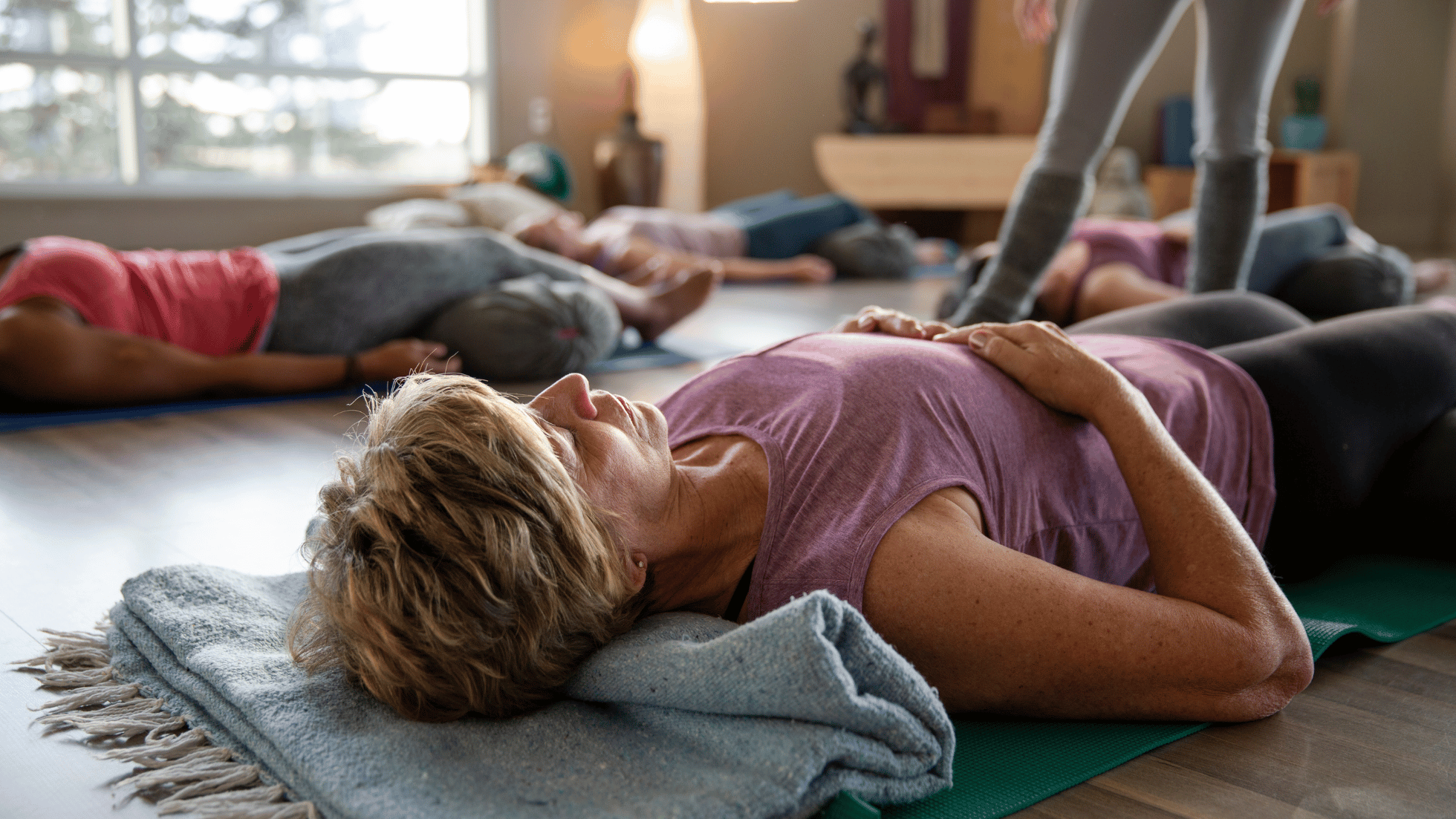If you’re looking for a way to unwind and destress, restorative yoga might be just what you need. This gentle form of yoga focuses on relaxation and restoration, using props like blankets, bolsters, and pillows to support the body in various poses. Unlike more active forms of yoga, restorative yoga is slow-paced and emphasizes deep breathing and mindfulness.

Finding a restorative yoga class near you is easier than ever. Many yoga studios now offer restorative yoga classes, and you can also find classes at community centers, gyms, and other fitness facilities. You can even take restorative yoga classes online, from the comfort of your own home. Whether you’re a beginner or an experienced yogi, restorative yoga is a great way to reduce stress, improve flexibility, and promote overall wellbeing.
Benefits of Restorative Yoga
Restorative yoga is a gentle and relaxing form of yoga that offers a range of benefits for both the body and mind. Here are some of the benefits of restorative yoga:
Physical Benefits
- Relieves tension and pain: Restorative yoga poses are designed to release tension and tightness in the muscles, which can help to alleviate pain and discomfort in the body.
- Improves flexibility: Restorative yoga poses are held for longer periods of time, which can help to improve flexibility and range of motion in the joints.
- Boosts immunity: Restorative yoga can help to stimulate the lymphatic system, which is responsible for removing toxins from the body and boosting immunity.
- Reduces blood pressure: Restorative yoga can help to lower blood pressure and reduce the risk of heart disease.
Mental and Emotional Benefits
- Reduces stress and anxiety: Restorative yoga encourages deep relaxation and helps to activate the parasympathetic nervous system, which can help to reduce stress and anxiety.
- Improves sleep: Restorative yoga can help to improve the quality of sleep and reduce the symptoms of insomnia.
- Enhances mood: Restorative yoga can help to release tension and promote feelings of calm and well-being, which can enhance mood and reduce symptoms of depression.
- Promotes mindfulness: Restorative yoga encourages mindfulness and helps to cultivate a sense of inner peace and awareness.
Overall, restorative yoga is a gentle and effective way to promote relaxation, reduce stress, and improve overall health and well-being.
Finding Restorative Yoga Classes

If you’re interested in trying restorative yoga, there are several places you can look to find classes near you. Here are a few options to consider:
Local Studios and Gyms
Many yoga studios and gyms offer restorative yoga classes as part of their regular schedules. Check the websites or schedules of local studios and gyms to see if they offer restorative yoga classes.
You can also call or email the studio or gym to ask about their class offerings. Some studios may offer discounts for new students, so be sure to ask about any promotions or deals.
Community Centers
Community centers and recreation departments may also offer restorative yoga classes. Check your local community center’s website or brochure for information on class schedules and pricing. Community centers may also offer discounts for residents or members, so be sure to ask about any available promotions.
Online Directories
Online directories such as ClassPass and Mindbody can help you find restorative yoga classes in your area. These directories allow you to search for classes based on location, class type, and schedule.
You can also read reviews from other students to get an idea of the quality of the classes. Keep in mind that some directories may require a membership or subscription fee to access their services.
No matter where you decide to look for restorative yoga classes, be sure to read class descriptions carefully to ensure that the class is suitable for your level of experience and fitness. It’s also a good idea to speak with the instructor before class to let them know about any injuries or health concerns you may have. With a little bit of research, you can find the perfect restorative yoga class to help you relax and unwind.
What to Expect in a Restorative Yoga Session
Restorative yoga is a gentle form of yoga that aims to relax the body and calm the mind. If you are new to restorative yoga, you may be wondering what to expect in a typical session. Here is a brief overview of what you can expect:
Session Structure
A typical restorative yoga session lasts between 60 and 90 minutes. During this time, you will be guided through a series of gentle poses that are designed to help you relax and unwind. Restorative yoga poses are held for longer periods of time than traditional yoga poses, usually between 5 and 20 minutes. This allows your body to fully relax and release tension.
Common Poses
Some common restorative yoga poses include:
- Supported Child’s Pose: This pose is done with a bolster or pillow placed between the legs and another one placed under the chest, allowing for a gentle stretch in the hips and lower back.
- Legs-Up-The-Wall Pose: This pose involves lying on your back with your legs up against a wall or other sturdy surface. It helps to relieve tension in the legs and lower back.
- Supported Bridge Pose: This pose is done with a block or bolster placed under the hips to gently stretch the lower back and hips.
Required Equipment
Restorative yoga requires some basic equipment to help support your body in the poses. Here is what you will need:
- Yoga mat: A non-slip yoga mat will provide a comfortable surface for your practice.
- Bolsters: Bolsters are long, firm pillows that are used to support the body in various poses.
- Blocks: Yoga blocks are used to provide support and stability in certain poses.
- Blankets: Soft blankets are used to provide warmth and comfort during the practice.
Overall, restorative yoga is a gentle and relaxing practice that can help to reduce stress and tension in the body. With the right equipment and guidance, anyone can enjoy the benefits of this restorative practice.
Preparing for Your First Class
If you’re new to restorative yoga, it’s important to prepare yourself before your first class. Here are some things to keep in mind to ensure a successful and enjoyable experience.
Choosing the Right Class
When looking for a restorative yoga class, it’s important to find one that suits your needs. Look for classes that are specifically labeled as “restorative” or “gentle.” These classes typically involve holding poses for longer periods of time with the help of props, allowing you to fully relax and unwind.
It’s also a good idea to check the level of the class. If you’re a beginner, look for classes labeled as “beginner-friendly” or “all levels.” These classes will be less intense and easier to follow, allowing you to get the most out of your practice.
What to Bring
Restorative yoga classes typically require very little equipment. Most studios will provide props such as blankets, bolsters, and blocks. However, if you have your own props, feel free to bring them along.
It’s also a good idea to wear comfortable, loose-fitting clothing that allows you to move freely. Avoid wearing anything too tight or restrictive, as this can make it difficult to fully relax during your practice.
Class Etiquette
When attending a restorative yoga class, it’s important to be respectful of others in the class. Arrive on time or a few minutes early to get settled in and avoid disrupting others. If you need to leave early, let the teacher know ahead of time.
During class, try to remain as quiet and still as possible. Avoid talking or fidgeting, as this can be distracting to others. And remember, restorative yoga is all about relaxation and letting go, so try to fully immerse yourself in the experience and let go of any outside distractions.



